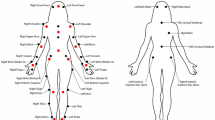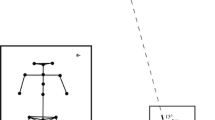Abstract
The purpose of this study was to characterize the movement qualities of 5 target emotions during walking. We used an autobiographical memories paradigm for elicitation and observer judgments for emotion recognition. For each of the felt and recognized emotion portrayals, 6 Effort-Shape qualities were judged on a continuum between opposite qualities at the anchor points. Three general categories of movement style emerged, so that anger and joy shared anchor qualities at one end of the continuum, sadness had qualities at the opposite anchor, and content and neutral had qualities between the anchor extremes. The Effort-Shape profiles were unique for each target emotion, however, and mean scores were different between emotions even when emotions shared similar qualities. Emotions were classified using the Effort-Shape scores with accuracies ranging from 74–32 % for sad, anger, content and joy, respectively. For most of the target emotions, decoding accuracy was related to at least 4 Effort-Shape qualities, suggesting that decoding accuracy may be associated with a profile of movement qualities. This study highlights the importance of movement quality in bodily expression of emotion and demonstrates the effectiveness of Effort-Shape analysis in distinguishing among emotion-related movement styles.

Similar content being viewed by others
References
Atkinson, A. P., Dittrich, W. H., Gemmell, A. J., & Young, A. W. (2004). Emotion perception from dynamic and static body expressions in point-light and full-light displays. Perception, 33(5), 717–746.
Crane, E. A., Gross, M. M., & Fredrickson, B. L. (2011). Feasibility of using a head-mounted camera to capture dynamic facial expressions during body movement. In D. England (Ed.), Whole body interaction, human–computer interaction series (Vol. XV, pp. 151–162). London: Springer.
de Gelder, B. (2006). Toward a biological theory of emotional body language. Biological Theory, 1(2), 130–132.
de Meijer, M. (1989). The contribution of general features of body movement to the attribution of emotions. Journal of Nonverbal Behavior, 13(4), 247–268.
Dell, C. (1977). A primer for movement description: Using effort-shape and supplementary concepts. New York: Dance Notation Bureau Press.
Dittrich, W. H., Troscianko, T., Lea, S. E., & Morgan, D. (1996). Perception of emotion from dynamic point-light displays represented in dance. Perception, 25(6), 727–738.
Gross, M., Crane, E., & Fredrickson, B. L. (2010). Methodology for assessing bodily expression of emotion. Journal of Nonverbal Behavior, 34(4), 233–248.
Gross, M., Crane, E., & Fredrickson, B. L. (2012). Effort-Shape and kinematic assessment of bodily expression of emotion during gait. Human Movement Science, 31(1), 202–221.
Laban, R., & Ullmann, L. (1988). The mastery of movement (4th ed.). Plymouth: Northcote House.
Labouvie-Vief, G., Lumley, M. A., Jain, E., & Heinze, H. (2003). Age and gender differences in cardiac reactivity and subjective emotion responses to emotional autobiographical memories. Emotion, 3(2), 115–126.
Levenson, R., Cartensen, L., Friesen, W., & Ekman, P. (1991). Emotion, physiology and expression in old age. Psychology and Aging, 6, 28–35.
Levy, J. A., & Duke, M. P. (2003). The use of Laban Movement Analysis in the study of personality, emotional state and movement style: An exploratory investigation of the veridicality of body language. Individual Differences Research, 1(1), 39–63.
Montepare, J., Goldstein, S. B., & Clausen, A. (1987). The identification of emotions from gait information. Journal of Nonverbal Behavior, 11(1), 33–42.
Montepare, J., Koff, E., Zaitchik, D., & Albert, M. (1999). The use of body movements and gestures as cues to emotions in younger and older adults. Journal of Nonverbal Behavior, 23(2), 133–152.
Pollick, F. E., Paterson, H. M., Bruderlin, A., & Sanford, A. J. (2001). Perceiving affect from arm movement. Cognition, 82(2), B51–B61.
Roether, C. L., Omlor, L., Christensen, A., & Giese, M. A. (2009). Critical features for the perception of emotion from gait. Journal of Vision, 9(6), 1–32.
Roether, C. L., Omlor, L., & Giese, M. A. (2008). Lateral asymmetry of bodily emotion expression. Current Biology, 18(8), R329–R330.
Wallbott, H. G. (1998). Bodily expression of emotion. European Journal of Social Psychology, 28(6), 879–896.
Wallbott, H. G., & Scherer, K. R. (1986). Cues and channels in emotion recognition. Journal of Personality and Social Psychology, 51(4), 690–699.
Author information
Authors and Affiliations
Corresponding author
Rights and permissions
About this article
Cite this article
Crane, E.A., Gross, M.M. Effort-Shape Characteristics of Emotion-Related Body Movement. J Nonverbal Behav 37, 91–105 (2013). https://doi.org/10.1007/s10919-013-0144-2
Published:
Issue Date:
DOI: https://doi.org/10.1007/s10919-013-0144-2




